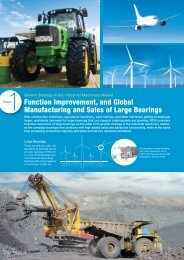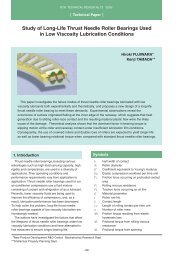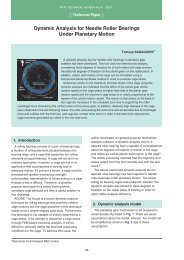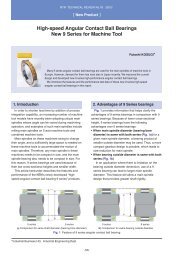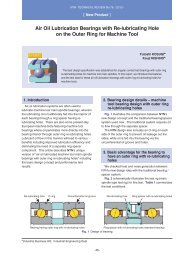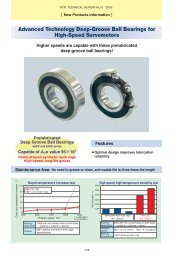Special Issue; Products for Industrial Machinery - NTN
Special Issue; Products for Industrial Machinery - NTN
Special Issue; Products for Industrial Machinery - NTN
You also want an ePaper? Increase the reach of your titles
YUMPU automatically turns print PDFs into web optimized ePapers that Google loves.
High-Speed Tapered Roller Bearing <strong>for</strong> Machine Tool Main Spindles<br />
There have been ef<strong>for</strong>ts to develop high-speed<br />
tapered roller bearings <strong>for</strong> machine tool main spindles,<br />
and an example 1) has been reported in which 1.25<br />
million dmn was achieved with a tapered roller bearing<br />
equivalent to the 32020 model. In this example,<br />
however, a <strong>for</strong>ced circulation lubrication system was<br />
employed with a lubricating oil flow rate that exceeds<br />
4 liters per minute. Un<strong>for</strong>tunately, this example is not<br />
practical as a replacement <strong>for</strong> a grease- or air-oillubricated<br />
combination of a double row cylindrical<br />
roller bearing and an axial load carrying angular<br />
contact ball bearing because of a greater lubrication<br />
cost and a greater power loss from the entire bearing<br />
system that includes this lubricating oil circulation<br />
system. The authors have conducted research,<br />
prototyping and experiments on high-speed<br />
application with an air-oil lubricated tapered roller<br />
bearing and have achieved an unprecedented 1.25<br />
million dmn. This paper reports on this achievement.<br />
2. Requirements <strong>for</strong> Higher Bearing Speed<br />
A challenge that must be addressed to achieve<br />
higher speed with a rolling bearing is limiting the<br />
temperature increase that results from higher bearing<br />
speed. If the temperature on a rolling bearing is<br />
excessively high, the preload varies greatly due to<br />
thermal expansion, and this in turn further promotes<br />
temperature increase. This problem is particularly<br />
apparent with definite position preloading systems,<br />
which are often used on bearing systems that must<br />
have very high rigidity.<br />
Arrangements <strong>for</strong> inhibiting temperature increases<br />
on a rolling bearing include a <strong>for</strong>ced circulation<br />
lubrication system and a jet lubrication system in<br />
which a large amount of lubricant is fed to a rolling<br />
bearing to remove heat from the bearing in an amount<br />
greater than the heat generated on the bearing that<br />
results from the viscosity of the lubricating oil.<br />
However, the authors did not employ either of these<br />
arrangements. In the case of air-oil lubrication<br />
systems in which small amounts of lubricating oil are<br />
fed to the rolling bearing with compressed air, the key<br />
to high-speed operation is minimization of the heat<br />
occurring from the running rolling bearing.<br />
Now, let us consider the heat generating factor, that<br />
is, the torque generation factor <strong>for</strong> the tapered roller<br />
bearing illustrated in Fig. 1. On a tapered roller<br />
bearing, the generatrix of the rollers intersects the<br />
prolonged line from the inner-outer ring raceway at a<br />
point on the rotation axis. There<strong>for</strong>e, sliding friction<br />
from spinning between rollers and raceway does not<br />
occur. 2) Also, since the mode of roller-bearing ring<br />
contact is linear contact, differential sliding does not<br />
Fig. 1 Section view of standard tapered roller bearing<br />
take place and the elastic hysteresis loss is usually<br />
small. 3) Given this, typical factors to be considered <strong>for</strong><br />
a high-speed tapered roller bearing include:<br />
1) EHL (elasto-hydrostatic lubrication) rolling<br />
viscous friction between rollers and the<br />
bearing ring<br />
2) Sliding friction between the roller large-end<br />
face and the rib face<br />
3) Sliding friction between the rollers and cage<br />
pockets<br />
4) Stirring friction with oil and air in the bearing<br />
First, the EHL (elasto-hydrostatic lubrication) rolling<br />
viscous friction between rollers and the bearing ring in<br />
1) can be determined with the following expression 4) :<br />
29.2RGU 0.648 W 0.246<br />
f EHL s, EHL t<br />
l (1)<br />
<br />
where, s, EHL is an EHL starvation coefficient that<br />
represents the degree that the amount of oil is<br />
insufficient, and can take a value in the range from 0<br />
to 1; t represents a correction coefficient derived<br />
from shearing heat generation occurring at the EHL<br />
inlet and is determined based on the load, bearing<br />
speed and lubricating oil physical properties; is the<br />
viscosity-pressure coefficient of the lubricating oil<br />
used; l stands <strong>for</strong> the contact length of the rollers: G, U<br />
and W are non-dimensional material, velocity and load<br />
parameters, respectively, and are uniquely determined<br />
by the geometrical shape and running speed of the<br />
bearing, the load, and the physical properties of the<br />
lubricating oil. There<strong>for</strong>e, if the geometrical shape of<br />
the bearing, operating conditions and the lubricating<br />
oil are given, the rolling viscous friction can be<br />
decreased by gradually decreasing s, EHL to zero by<br />
allowing starvation to occur whenever possible by<br />
-17-



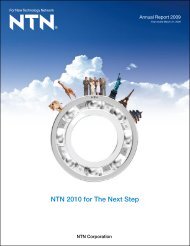
![[New Product] Unit Products for Office Equipment - NTN](https://img.yumpu.com/27154451/1/184x260/new-product-unit-products-for-office-equipment-ntn.jpg?quality=85)
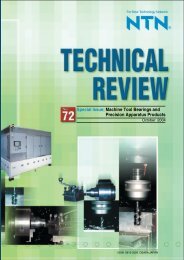
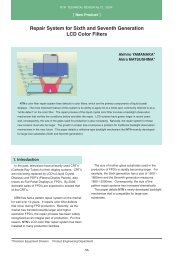
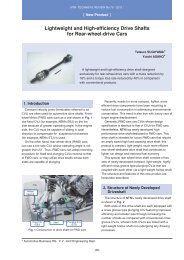
![[New Product] Development of Oil-impregnated Sintered ... - NTN](https://img.yumpu.com/27154427/1/184x260/new-product-development-of-oil-impregnated-sintered-ntn.jpg?quality=85)

